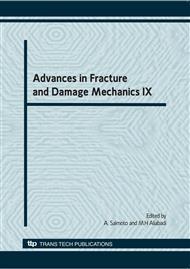p.821
p.825
p.829
p.833
p.837
p.841
p.845
p.849
p.853
Calculation of Stress Intensity Factor under Mixed Mode Biaxial Tensile Load by Photoelastic Hybrid Method
Abstract:
In this study, the photoelastic experiment hybrid method was introduced and applied to the fracture problems of the isotropic polycarbonate plate with a central crack under the uniaxial and equibiaxial tensile load. The influences of equibiaxial tensile load on the isochromatic fringes and stress fields, stress intensity factors near the mixed mode crack-tip were investigated. As the results, without relation to the inclined angle of crack, the asymmetric isochromatic fringes around the crack propagation line under uniaxial tensile load has become symmetric and the slope of isochromatic fringe loop has inclined toward crack surface when an equal lateral tensile load was added. Furthermore, the distribution of all stress components have changed from asymmetric shape to symmetric shape, and only the range of compressive stress of σχ/σ0 have changed as compared with the mode I condition under unaxial load with β = 0°. When an equal lateral tensile load was added to uniaxial load, the value of stress intensity factors are little changed when β = 0° but the values of KI /K0 are increased and KII /K0 are become zero, that is, mode I situation when β = 15°~45°.
Info:
Periodical:
Pages:
837-840
Citation:
Online since:
November 2010
Authors:
Price:
Сopyright:
© 2011 Trans Tech Publications Ltd. All Rights Reserved
Share:
Citation:


